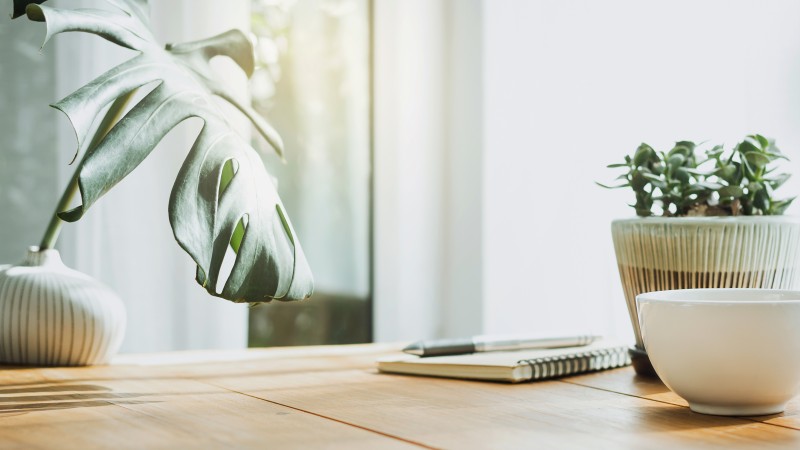Unlocking the Full Potential of Your Home Office: Small Changes for Big Impact
Are you looking to enhance your productivity and well-being while working from home? In this blog post, we have collected small, affordable adjustments that can make a massive difference in your home office setup. From the placement of your desk and the surrounding furniture to the lighting, colors and air quality, every aspect plays a crucial role in optimizing your workspace. Get ready to transform your workspace and elevate your work-from-home experience to new heights.
(10min read)
Content:
- Lighting - Balance Natural and Artificial Light Sources
- The Perfect Home Office Desk Setup
- Applying Feng Shui Principles
- Boost Your Work Productivity and Satisfaction with Office Plants
- Choosing the Right Colors for Your Home Office
Lighting - Balance Natural and Artificial Light Sources
When it comes to creating an ideal home office space, lighting conditions play a big role in both our productivity and overall well-being.
Natural Lighting: Harnessing the Power of Daylight
Daylight not only illuminates our surroundings but also affects our internal clock, influencing our performance and well-being. Access to natural light and a view of the outside world helps combat the feeling of confinement often associated with spending extended periods indoors. It provides a refreshing visual break and contributes to a healthier work environment. PLUS, utilizing natural light effectively can help reduce your energy consumption.
If you can, choose the room with the most natural light. It is recommended from the Deutsche Gesetzliche Unfallversicherung (DGUV), that office spaces should have a minimum lighting intensity of 500 Lux. This level of brightness was achieved in laboratory tests when the outdoor lighting conditions measured approximately 5000 Lux, simulating a typical cloudy November day.
Ideally, position your desk about half a meter away from the window, ensuring that your eye line remains parallel to the window. This arrangement prevents direct light from causing glare on your computer screen and helps maintain a comfortable working environment.
Artificial Lighting: Enhancing Workspaces with Artificial Light
While natural lighting should be the primary focus, there are instances where artificial lighting becomes necessary or complements the available daylight. Artificial light cannot replicate the positive effects of daylight, but it can be used to augment illumination in darker spaces. However, it is essential to strike a balance between the two and avoid relying solely on artificial light sources. Consider the following tips to optimize artificial lighting in your home office:
- Avoid sitting directly beneath a light source that shines straight down, as this can create harsh shadows or cause visual discomfort. Instead, position yourself between two ceiling lights that are out of your direct line of sight while effectively illuminating your workspace.
- Consider using a desk lamp to provide additional lighting, particularly if the overall lighting in the room is insufficient. Choose a lamp with indirect lighting capabilities to diffuse the light and reduce strain on your eyes while reading.
- Ensure that standing lights are directed towards your desk, but position them in a way that the light bulb is not directly visible to prevent glare. Additionally, opt for a matte finish on your desk surface to minimize light reflections that could cause visual disturbances.
The Perfect Home Office Desk Setup
From desk height to organization and even the principles of feng shui, here’s a guide to help you create the perfect home office desk situation.
Ergonomics for a Healthy Workstation
The next few paragraphs may sound very technical, they are results of long studies and you sure have heard some of them before. Some of these tips may sound not appealing to you, but if you struggle with back or neck pain, you may want to consider trying a few of them. Proper ergonomics play a crucial role in maintaining a healthy posture and avoiding discomfort or pain.
According to guidelines from the German Federal Institute for Occupational Safety and Health (BAuA), your desk chair should be adjusted to form a 90-degree angle between your upper and lower legs when your feet are flat on the floor. Additionally, the desk itself should be set up so that your upper and lower arms form a 90-degree angle when resting on the tabletop.
Position your keyboard centrally in front of your upper body, and place your mouse as close to the keyboard as possible. This arrangement helps to minimize strain on your wrists and arms.
Optimal Desk Size and Screen Placement
The ideal desk size for a home office is 80 by 200 centimeters, but a width of 160 centimeters is also acceptable. The distance between your eyes and the screen should be between 60 and 80 centimeters.
To ensure comfortable viewing, the top row of the screen should be positioned approximately 25 centimeters below eye level. This slight downward tilt helps maintain a natural line of sight and reduces strain on your neck and eyes.
Back Pain Prevention
Back pain is a common issue among office workers, but proper workspace design can help prevent it. The BAuA recommends that office workstations should occupy a space of at least eight to ten square meters. This space includes the desk, chair, and room for movement. We know that approximately only 50% of all home offices are in a dedicated room, but knowing this may after all help you select your spot in your apartment.
If you can, leave a minimum of one meter of space between your desk and any furniture behind you, and ensure that you have approximately one meter of movement space to the left and right of your seated position. These guidelines allow for freedom of movement and prevent a cramped workspace.
It’s important to note that the rules for desk setup generally assume a straight sitting posture. However, maintaining the same position for extended periods can lead to muscle tension and reduced blood circulation. Consider incorporating regular breaks and stretches into your work routine to alleviate this issue.
Applying Feng Shui Principles
You are already doing all the above and still don’t feel all that good with your setup? You may want to try out feng shui. Incorporating feng shui principles into your home office can enhance the overall energy and balance of the space. While feng shui sometimes is regarded a bit “woo woo”, that is maybe because the underlying principles that utilize light and our position in the room are never fully explained with it. We don’t have the space to explain it here either - just consider this: nobody likes to sit with their back to a door, right? Try the following tips:
Position your desk with your back against a wall and facing the door. This arrangement provides a sense of support and allows you to have a clear view of the room. Avoid sitting directly in front of a wall, as it symbolically represents a “block” in your path. If your desk is not against a wall, use a room divider or a slightly taller sideboard as a backing.
Opt for closed cabinets, sideboards, and drawers rather than open shelves and non-lockable storage. Keeping your focus on your work and avoiding visual distractions can improve concentration and productivity.
Creating a Positive Work Environment
Following up on the last feng shui advice, the visual and organizational aspects of your home office can significantly impact your focus and motivation. We have collected a few tips for a well-organized and visually appealing workspace.
First, assess your surroundings consciously. Eliminate clutter and distractions that can negatively impact your subconscious mind. Replace outdated photos or distracting visuals with a picture or object that provides depth and a sense of outlook.
Choose closed storage options, such as cabinets and shelves, to maintain a tidy and organized appearance. Utilize shelves, storage baskets, filing boxes, hanging folders, and magazine holders to create a structured system within your storage space.
And lastly, the everlasting struggle, that can make a big visual difference: tackle cable clutter and strive for a clean and tidy cable management solution. Cable channels, tunnels, ties, boxes or guides come in various forms, sizes and prices, there is something for you out there. Just tying them together to create just “one” out of many cables can do the trick to lessen the chaos. Be mindful though that some cables don’t like to be bent too much. Label the cables if you have many, so you don’t accidentally pull out the wrong one.

Boost Your Work Productivity and Satisfaction with Office Plants
What is more visually appealing than a beautiful plant? A low-maintenance plant!
Another simple yet effective solution to enhance your home office is to bring the outdoors in by incorporating office plants into your workspace. Not only do they add a touch of nature to your environment, but they also offer several benefits that can enhance your work-from-home experience.
Low Maintenance, High Impact
When selecting office plants for your home workspace, prioritize low-maintenance options. These plants can thrive with minimal care, making them ideal for busy professionals who still wish to enjoy the benefits of nature in their home office. You find a list of options further below.
A Breath of Fresh Air
Office plants can do more than just look pretty; they can improve the air quality around your desk. They act as natural air purifiers, removing harmful pollutants and promoting better respiratory health and overall well-being.
Boosted Productivity and Reduced Stress
Studies have shown that having plants in the workspace can lead to increased productivity and reduced stress levels. The sight of greenery can create a calming and soothing atmosphere, helping you stay focused and motivated during work hours.
A Green Oasis of Creativity
Embracing office plants can also boost your creativity and problem-solving abilities. Nature has a way of stimulating innovative thinking, which can be invaluable for brainstorming and creative tasks.
The 14 Best Office Plants
While any plant can offer some of these benefits, consider your home office’s specific conditions when choosing the right green companions. Opt for plants that match your workspace’s light and water conditions and require minimal maintenance to thrive.
By introducing low-maintenance office plants into your home workspace, you can create a refreshing and inspiring environment that fosters productivity and job satisfaction. Embrace the power of nature and watch as your home office transforms into a green oasis of productivity and well-being.
Here’s a list of office plants that not only require minimal care but can also thrive in various light and water conditions:
- Snake Plant: Also known as “Mother-in-Law’s Tongue,” the snake plant is virtually indestructible. It can tolerate low light and infrequent watering, making it an ideal choice for even the most forgetful plant owners.
- English Ivy: This beautiful vine can grow well with average water and medium light levels. It’s an excellent option for adding a touch of green to your workspace without demanding too much attention.
- ZZ Plant: The ZZ plant is a hardy and resilient plant that can thrive in low-light conditions and with little water. It’s the perfect desk companion for those with busy schedules.
- Aloe: If your desk is located near a sunny window, the Aloe plant can be a great addition. It requires lots of bright light but can withstand occasional neglect.
- Philodendron: With regular moisture, a Philodendron can bring a lush and vibrant look to your workspace. Opt for a self-watering pot to make caring for it even easier.
- Lucky Bamboo: This plant thrives in low-light environments and can bring an element of Feng Shui to your office space.
- Pothos: Known for its easy care, the Pothos plant enjoys bright and indirect light, making it a versatile choice for various office setups.
- Cactus: Many adorable cactus types exist, and they rarely need to be repotted. Find a sunny spot for them, and they’ll thrive with minimal attention.
- Spider Plant: Warm places with slightly moist conditions are ideal for the Spider Plant. It’s fast-growing and may need repotting if it starts looking sparse.
- Peace Lily: Symbolizing hope and healing, the Peace Lily prefers loose potting soil and should be kept more underwatered than overwatered. Be cautious if you have pets, as it is toxic to animals.
- Jade Plant: Often referred to as the “money plant,” the Jade Plant requires ample light but can be left on its own for long periods.
- Weeping Fig / Ficus: An evergreen plant that thrives with an abundance of sun and water. Once situated, avoid moving it around frequently.
- Parlor Palm: This plant can tolerate low light but dislikes excessive watering. Its leaves will turn yellow as a sign of dehydration, making it helpful to know when to water.
- Ponytail Palm: This slow-growing, long-living plant is perfect for those who might forget to tend to their green companions regularly.
Choosing the Right Colors for Your Home Office
We have already talked about how significant a role factors like organization, lighting, plants and can play, but one element often overlooked is the impact of colors on our work environment. The colors you choose for your home office can have a profound effect on your mood, focus, and overall productivity. Let’s explore the top colors that can transform your workspace and boost your efficiency.
White: Embrace the Airiness
In smaller home office spaces, white is an excellent choice to create a sense of openness and airiness. This color reflects light, making the area feel more spacious and inviting. It also provides a clean and minimalistic backdrop, allowing you to focus better on your tasks without unnecessary distractions.
Gray: A Balanced Neutral
Gray is a versatile and balanced neutral color that complements various styles and coordinates well with other furniture or colorful accessories. When the need for intense focus is essential, neutrals like gray create a non-distracting background, helping you maintain concentration throughout the workday.
Blue: Efficiency at Its Best
Blue is often hailed as the best color for office productivity. It’s associated with feelings of calmness, focus, and efficiency. Incorporating shades of blue into your home office can promote a serene and productive atmosphere, making it easier to tackle tasks and stay on track.
Yellow: Unleash Your Creativity
If your work requires a boost of creativity, yellow is the color to consider. Known for its association with positivity and innovation, this vibrant hue can spark creativity and fresh ideas in your home office. However, use it sparingly as too much yellow can be overwhelming.
Green: A Calming Oasis
For a calming and harmonious office environment, green is an excellent choice. Green is often linked to nature and relaxation, helping reduce stress and anxiety while creating a pleasant and serene atmosphere. It’s a great option if you want to foster a sense of balance and well-being in your home workspace.
How to Choose?
While these colors can positively impact your productivity, it’s essential to select shades that align with your personal preferences and work requirements. Keep these tips in mind when choosing colors for your home office:
Consider Your Work Type
Different colors have distinct effects on our emotions and cognitive abilities. Think about the type of work you do and the qualities you want to enhance—focus, creativity, calmness, etc.
Avoid Overstimulation
While bold and vibrant colors can be energizing, too much of them can lead to overstimulation and distraction. Balance brighter shades with neutral tones to maintain a harmonious atmosphere.
Personalize Thoughtfully
Personal touches are essential for making your home office feel comfortable and inviting. Add pops of color through artwork, plants, or decorative accents to inject personality without overwhelming the space.
If you’re unsure about which colors to choose, start with smaller elements like throw pillows, rugs, or wall art. Observe how they make you feel before committing to painting entire walls.
Let the Transformation Begin!
Now you have all the tools to up your home office game. Some things are small changes indeed, that can make a big difference. Why don’t you try some of them out? Tell us if so, and we are curious to learn what you have done to make your home office work better for you!


Comments
Leave a Reply
Your email address will not be published. Required fields are marked